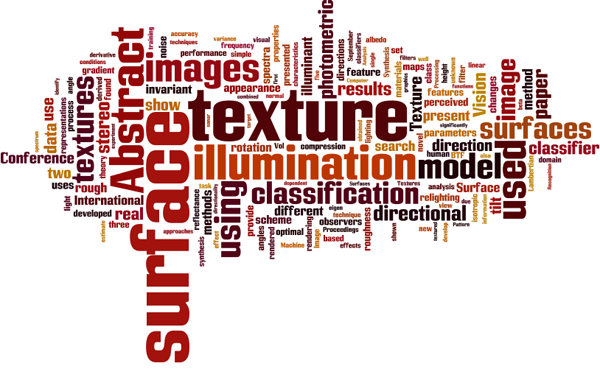Description
This database is intended to provide physics-based, photometric data for texture research. We use the term texture research to encompass work in texture segmentation and classification, shape from texture, visualisation and rough surface modelling. We use photometric in the context of photometric stereo: i.e. inferring information about a static scene by altering the lighting conditions. In computer vision the term physics-based is applied to algorithms that model, or account for, the physical process of image formation and capture. We describe this database as being physically-based because we have imaged the surfaces under controlled conditions, and have taken calibration images that enable the imaging process to be modelled.
The database holds images of rough surfaces that have been illuminated from various directions. Images that allow the user to calibrate the image transfer function, and measure the noise in the process are also held in the database.
We believe this database will be of use to texture researchers working on illuminant direction invariance, surface rotation invariance and photometric shape estimation.
Scope
This database holds images of rough surfaces. The main variables are the azimuth and zenith of the illumination. In some cases the sample is also rotated.
Image Characteristics
-
Monochromatic
-
Resolution: 1280 x 1024
-
Accuracy: 12 bit, dynamic range 66dB
-
Fixed and linear gain: images measured under different lighting conditions are comparable.
-
unprocessed TIFF images.
Physics Based
This database is intended for physics based vision. This means we aim to be able to relate the intensity of a given pixel to the properties of the corresponding patch of the test surface. This affects several aspects of the imaging process.
-
Linear and fixed gain: measured intensity is proportional to irradiance.
-
Scaling: the field of view of the camera is adjusted to cover an area of specified dimensions. Assuming that tangential distortion is not significant, this means that each pixel corresponds to an area of the surface of known dimensions.
-
Imaging Transfer Function: the database has several sets of calibration images corresponding to the optical setup at which images were captured. These allow the transfer function between the surface and the measured image to be estimated.
-
Noise: the database contains images that can be used for the estimation of noise in the image. Together with the transfer function images these allow the imaging process to be modelled and, to a certain degree, reversed.
The data held in this database is unprocessed. Our approach is to provide what we believe to be sufficient calibration data and allow the user discretion to apply his own models of the imaging process. Later in this manual we will discuss the imaging process and suggest an empirical model. Although we leave this to the user we do strongly recommend the use of the Registration images to remove lighting variations in the image.
Applications
We believe this database will be useful to researchers interested in extracting and processing information from rough surfaces.
Equipment
All the images in the texture database where captured using the Vosskuhler CCD 1300LN digital camera (specifications of this camera can be accessed via www.vdsvossk.de). This was used with a Matrox PC-SIG framestore.
Technical Information for the Digital Camera CCD 1300LN:
-
Resolution: 1280(H) by 1024(v) pixels
-
Pixel size: 6.7 um by 6.7 um
-
Progressive scan
-
Interline-transfer sensor (IT)
-
Active sensor size: 8.58(H) mm by 6.86(V) mm
-
Electronic shutter up to 1/100000 sec. (Image on demand)
-
Effective dynamic: up to 1:2000 (>=66 dB)
-
Digital output: 12-bit, RS-644
-
Frame system: 1050 lines
-
Power supply: +12V, max 0.45A
-
Lens mount: C-mount (2/3″)
Format
All the image sets are in various formats and in SCOPE format. More information about the scope format can be found here.
Organization
The image files are named according to the following format:
EXAMPLE: 0.aaa.30.45.90.bmpThe image aaa has been captured under the illumination condition with the slant angle of 45° and the tile angle 90° at the surface orientation angle of 30°.
Photex Download
Please download the Photex Database from the link below:
http://www.macs.hw.ac.uk/texturelab/files/resources/Photex_Database.zip
Warning: The database zip file is 6.5GB in size.
Individual files available here:
Acknowledgments
We wish to thank Stefan Karlsson for his observations.


